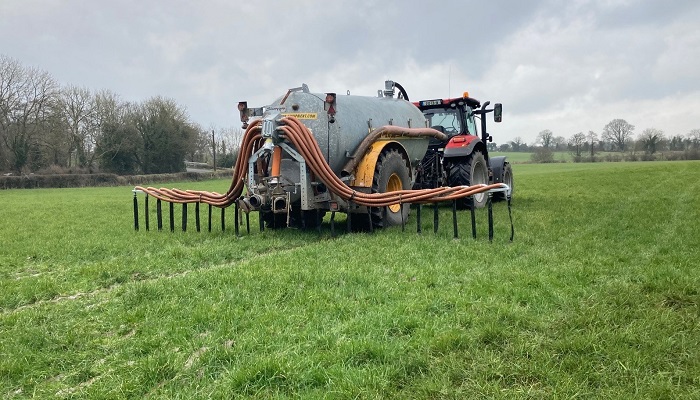30 March 2022
Reducing the Risks of Slurry Application

Maximising the fertiliser benefits from slurry is critical in 2022. Farmers are aware of this valuable resource and how it can help reduce their overall fertiliser bill through early spring application. However, best practice and regulation must be followed says Kieran Kenny ASSAP Advisor, Castlerea
Early slurry spreading can lead to increased nutrient loss to waterbodies if best practice and regulation is not followed. Here are a few points to consider:
Ground conditions
It is essential to carry out a thorough assessment of the land in advance of booking the contractor or using your own machinery. Ground conditions should be good or good/firm. Conditions that are soft or heavy, with a soil moisture deficit of < 5mm are not suitable. Applying slurry in conditions approaching saturation will lead to a high risk of nutrient losses. Improving field trafficability by way of tractor or machinery modifications will not reduce this risk. Ideally the early applications should be planned on free draining soils and delay applying on the higher risk poorly draining soils until late spring or early summer
Weather
Weather conditions before and after spreading are also important. The soil temperature should be at a minimum 60C and rising. This ensures the grass is growing and ready to take up the applied nutrients. No heavy rainfall (15mm in 24hour period) should be forecasted for at least 2 days afterwards, increasing to at least 3 days on poorly draining soils. Hence, the need to check the regional forecast regularly for rainfall and soil moisture deficits. Apply the slurry at appropriate rates to meet seasonal crop demand and avoid over application and overlapping. Using new technology such as GPS will help ensure precision application in the field, while flow meters attached to umbilical systems will assist in measuring application rates.
Buffer Zones
The implementation of Buffer Zones and Safeguard Zones are critical for the protection of water quality including drinking water. It is essential you do not spread slurry within: 5m of surface waterbodies, 10m of waterbodies where there is a moderate or severe slope, 15m of karst features (such as swallow holes and enclosed depressions), 20m of a Lake Shoreline or Turlough and up to 200m of a water abstraction point for human consumption. Inappropriate slurry spreading within the Zone of Contribution for a drinking water source can lead to contamination with microbial pathogens.
The buffers above are the minimum requirements for regulation. However, if a farmer wishes to extend these it will be even more positive for water quality.
Apply the slurry at appropriate rates to meet seasonal crop demand and avoid over application and overlapping.
The Agricultural Sustainability Support and Advisory Programme (ASSAP) is an advisory service available to all farmers situated in Priority Areas for Action to support with farming and water quality issues. For further details visit: Farming for water quality ASSAP
You might also be interested to access the Teagasc Slurry Calibration Tool here.
